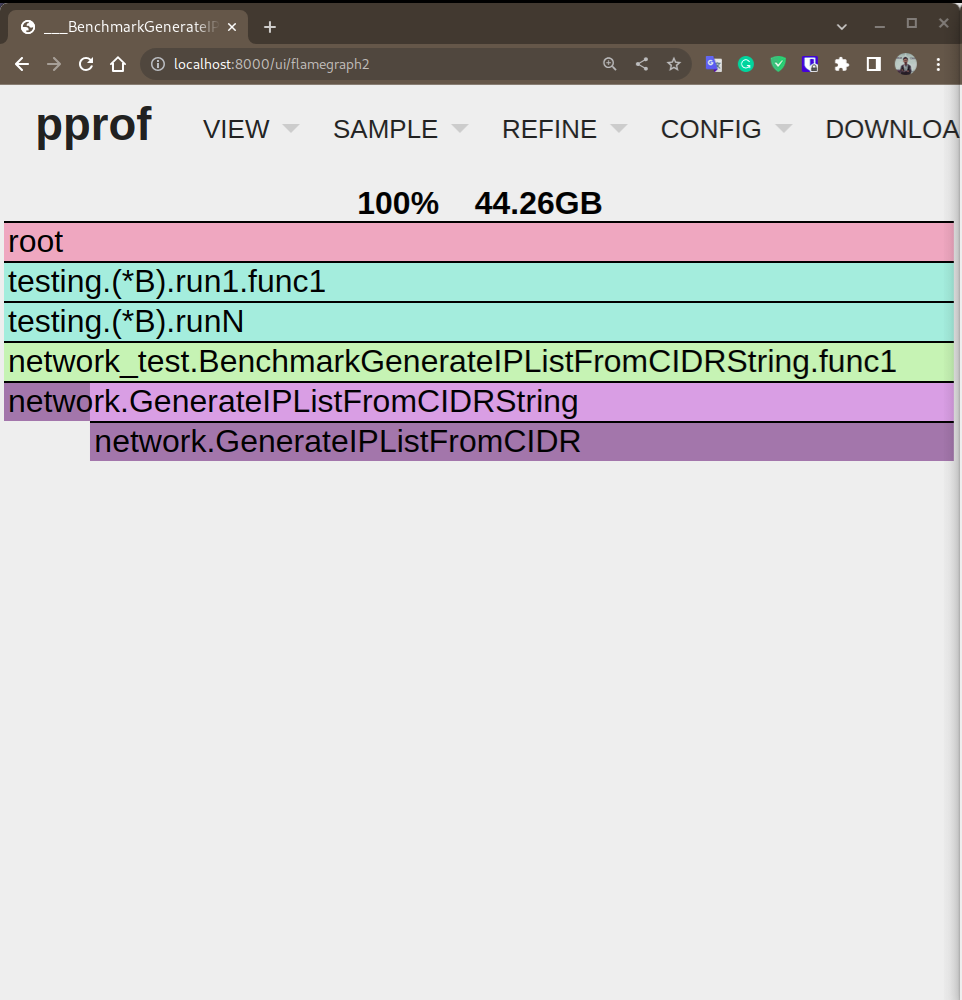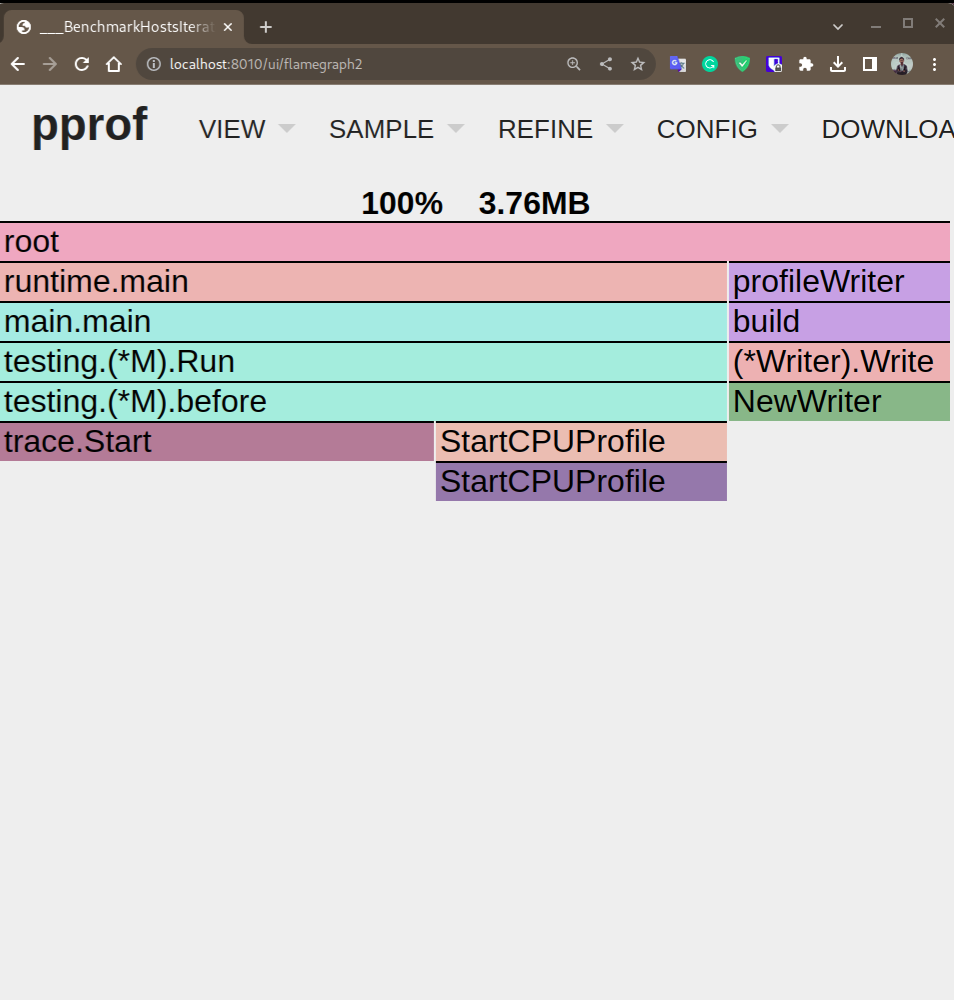Proyek: subping
Isu yang Berkaitan: https://github.com/fadhilyori/subping/issues/23
Latar Belakang
Selama proses pengembangan subping, tim kami mengalami masalah kritis yang melibatkan kebocoran memori yang secara khusus terjadi saat menangani sejumlah besar IPv6 host. Kebocoran memori ini berdampak negatif pada performa aplikasi dan menimbulkan kekhawatiran terkait stabilitas dan skalabilitasnya.
Kami telah mengamati bahwa kebocoran menjadi lebih jelas karena jumlah host IPv6 meningkat. Pengamatan ini mengarahkan kami untuk menyelidiki seluk-beluk penanganan host IPv6 dan dampaknya terhadap manajemen memori dalam aplikasi. Peningkatan konsumsi memori yang signifikan dalam kondisi ini menunjukkan adanya kebocoran memori. Pengujian dan simulasi ekstensif telah memastikan intensitas kebocoran dan korelasi langsungnya dengan beban kerja. Sebagai hasilnya, kami telah melakukan investigasi terfokus pada dinamika kompleks antara penanganan host IPv6 dan manajemen memori. Berbekal pengetahuan ini, kami telah memulai pengembangan solusi optimal untuk memastikan stabilitas dan efisiensi subping.
Untuk mendapatkan wawasan lebih lanjut dan mengatasi masalah ini secara efektif, kami telah memulai uji tolok ukur yang komprehensif. Pengujian ini bertujuan untuk mengevaluasi performa aplikasi dalam berbagai skenario, dengan fokus khusus pada pemantauan penggunaan memori selama pemrosesan host IPv6. Melalui uji tolok ukur ini, tujuan kami adalah mengungkap pola dan perilaku yang akan membantu kami mengidentifikasi akar penyebab kebocoran memori.
Tujuan utama kami adalah memastikan solusi yang stabil dan efisien untuk menangani host IPv6 dalam aplikasi subping.
Masalah Utama
The following code snippet demonstrates a function called GenerateIPListFromCIDR that generates a list of IP addresses within a specified range using CIDR notation. However, careful examination reveals a memory leak in the implementation, which can lead to inefficient memory usage over time.
| |
The memory leak in this code arises due to a combination of factors. Firstly, each IP address generated within the range is appended to the ips slice using the append function. However, with each append operation, a new copy of the IP address is created using make and copy, resulting in unnecessary memory allocation and consumption.
Furthermore, the original implementation includes the line append([]net.IP{}, ips...) at the end of the function, which creates a new slice and copies all IP addresses from the ips slice. This duplication further exacerbates the memory usage issue.
The Solution: Utilizing the Iterator Design Pattern
To address the memory leak issue and optimize the code, we have utilized the Iterator design pattern. This pattern enables us to encapsulate the iteration logic and provide a consistent interface for traversing individual host IP addresses within the specified CIDR range.
By applying the Iterator design pattern, we achieve a clear separation of concerns, keeping the traversal behavior decoupled from the underlying data structure. This promotes loose coupling and enhances code maintainability, as clients can now access elements sequentially without being exposed to the implementation details of the data structure.
In our solution, we introduced the HostsIterator struct, which serves as the iterator. It takes responsibility for maintaining the iteration state and provides a method (Next) to advance to the next IP address. By encapsulating the iteration logic within the HostsIterator struct, we adhere to the principles of the Iterator design pattern.
To ensure an organized codebase, we suggest placing the HostsIterator struct and its associated methods (NewHostsIterator and Next) in a dedicated file or section that focuses specifically on iterator-related functionality. This approach promotes a clear separation of concerns and facilitates easy reuse and future extension of the iterator implementation.
By leveraging the power of the Iterator design pattern, we enhance the clarity and maintainability of our code. Clients can now seamlessly iterate over host IP addresses within a CIDR range using a consistent and intuitive interface.
The Iterator Design Pattern
The Iterator design pattern is a behavioral design pattern that provides a way to access elements of an aggregate object sequentially without exposing its underlying representation. It separates the traversal behavior from the aggregate object, allowing clients to access elements in a consistent manner without knowing the internal structure of the object.
Key Participants
The Iterator design pattern typically involves the following key participants:
- Iterator: Defines the interface for accessing elements in the collection.
- ConcreteIterator: Implements the Iterator interface, keeps track of the current position in the collection, and provides methods for traversing the collection.
- Aggregate: Defines the interface for creating an Iterator object.
- Concrete Aggregate: Implements the Aggregate interface and returns a ConcreteIterator that traverses the collection.
Benefits of the Iterator Design Pattern
The Iterator design pattern offers several benefits, including:
- Separation of Concerns: The pattern separates the traversal behavior from the underlying collection, promoting a clear separation of concerns.
- Decoupling: Clients can iterate over elements without being exposed to the internal structure of the collection, reducing dependencies.
- Flexibility: It allows for multiple iterators to coexist and iterate over the same collection independently.
- Consistency: Provides a unified interface for iterating over elements, regardless of the specific collection implementation.
Graph Representation
The following graph illustrates the structure of the Iterator design pattern:
The New Code
HostsIterator represents an iterator for traversing the individual host IP addresses within a given CIDR range.
NewHostsIterator creates a new HostsIterator instance for the specified CIDR range. It parses the CIDR string, initializes the iterator with the first IP address in the range, and returns a pointer to the HostsIterator.
Next advances the iterator to the next host IP address. It increments the IP address by one, starting from the least significant byte, until a non-zero value is encountered or the entire address has been traversed. The modified IP address is stored in the HostsIterator’s CurrentIP field. The method returns a pointer to the modified IP address.
| |
Next2 is an optimized version of Next() function.
| |
Benchmark Results
For the purpose of performance evaluation, we have chosen IPv6 as the IP version, specifically utilizing a CIDR of 2001:db8:1::/100. This CIDR encompasses a total of 268.435.456 hosts, ensuring a substantial amount of data for a reliable assessment of performance.
| Function Name | Execution Count | Avg Execution Time | Memory Allocation | Memory Allocation per Operation |
|---|---|---|---|---|
| GenerateIPListFromCIDRString | 1 | 139.9 seconds | 47.5 GB | 268.4 million |
| Iterator_Next | 1 | 53.8 seconds | 4.3 GB | 268.4 million |
| Iterator_Next2 | 1 | 43.9 seconds | 6.4 GB | 268.4 million |
Execution Time
- Iterator_Next: 53.8 seconds
- Iterator_Next2: 43.9 seconds
- GenerateIPListFromCIDRString: 139.9 seconds
Based on the execution time, the Iterator_Next2 function performed the best, followed by Iterator_Next, while GenerateIPListFromCIDRString had the highest execution time.
Memory Allocation
- Iterator_Next: 4.3 GB
- Iterator_Next2: 6.4 GB
- GenerateIPListFromCIDRString: 47.5 GB
In terms of memory allocation, the Iterator_Next function had the lowest memory allocation, followed by Iterator_Next2, whereas GenerateIPListFromCIDRString had the highest memory allocation.
Memory Allocation per Operation
- Iterator_Next: 268.4 million
- Iterator_Next2: 268.4 million
- GenerateIPListFromCIDRString: 268.4 million
The number of memory allocations per operation remained consistent for all benchmarks, with each function performing approximately 268.4 million allocations per operation.
Memory Usage
We observed significant differences in memory usage between the GenerateIPListFromCIDR function and the HostsIterator. The GenerateIPListFromCIDR function exhibited high memory usage, consuming approximately 44.26 GB of memory to store the slice of IPv6 hosts. In contrast, the HostsIterator function demonstrated efficient memory management, utilizing only 3.76 MB.
This stark contrast highlights the advantage of using the HostsIterator function over the GenerateIPListFromCIDR function in terms of memory efficiency. By employing the HostsIterator approach, we can significantly reduce memory consumption while effectively handling a large range of IPv6 hosts.
- GenerateIPListFromCIDR

- Iterator

Based on the benchmark results, the Iterator_Next2 function performed the best in terms of execution time, while Iterator_Next had the lowest memory allocation. This highlights the advantages of optimizing memory usage by using appropriate data structures and algorithms, leading to efficient resource utilization within the network package.
It is important to note that the benchmark results do not directly address the effectiveness of the Iterator design pattern in resolving the memory leak problem. To determine if implementing the Iterator design pattern can solve the issue, further analysis of the code implementation and a detailed understanding of the specific nature of the memory leak would be required.